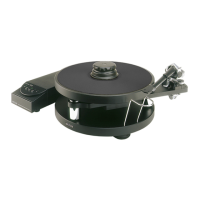The colour coding is as follows:
Red - right channel Green - right channel ground
White - left channel Blue - left channel ground
2. The LCOFC cartridge leads, Part No. 4899, can be replaced
and may be obtained from your dealer or SME Ltd.
3. Four lengths of alloy screw, nuts and washers are
provided for cartridge fixing:
6.5mm (1/4”) 11mm (7/16”) 16mm (5/8”) 19mm (3/4”)
Select a pair, using the shorter if more than one length is suitable. For the purist, use
without the finger lift is preferred but it is unlikely that the difference will be audible.
When used, the two stainless steel washers should first be placed in the counter-bores in
the headshell.
4. Examine the top of the cartridge. It is important that it presents a good flat face to the
underside of the headshell. Before final tightening check that the cartridge is lying parallel
to the reference edge of the headshell.
5. Tighten the cartridge fixing screws securely using a screwdriver which must be a good fit
in the screw-slots to avoid damage. If necessary hold the nut with the 5.0/5.5 A/F spanner
to prevent rotation. The screws are non-magnetic. Damage can be caused if a screw is
snatched by magnetic attraction whilst being offered up to the cartridge. For the same
reason do not lay tools down nearby.
15. Fitting the Headshell
1. Using the 2mm A/F hexagon wrench release the headshell clamp-bolt and remove it. The
nut should remain in its housing in the underside of the headshell as it is retained there
with adhesive.
2. Offer up the headshell to the tone-arm identifying the half-round key-way near the front.
3. As the headshell is pushed onto the tone-arm resistance will be felt as the spring loaded
contact pins in the tone-arm are compressed.
4. Align the bolt-hole in the headshell clamp-boss with the key-way in the tone-arm and
insert the clamp-bolt until it touches the nut. Tighten lightly using the 2mm A/F hexagon
wrench.
Removing the headshell
Using the same wrench, release the clamp-bolt and unscrew it. To remove the bolt push
the headshell onto the tone-arm using just enough pressure to overcome the spring loaded
contact pins in the tone-arm plug. The clamp-bolt should now be loose enough to lift out
using the long leg of the wrench and applying slight side pressure so that it does not slip
out of the socket. The nut remains in its housing in the underside of the headshell where it
is retained with adhesive.
Red

